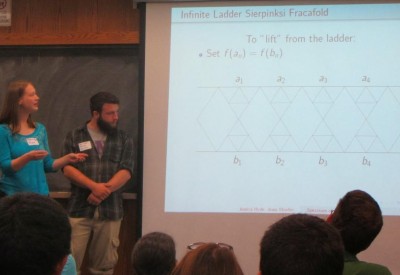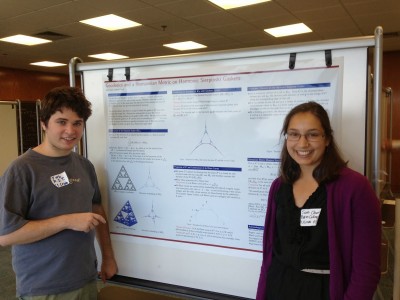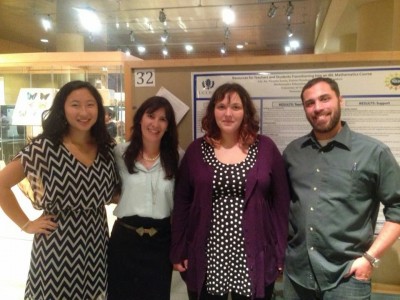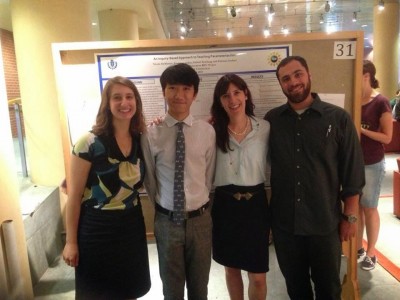Presentation
Resources for Teachers and Students Transitioning Into an IBL Mathematics Course
UConn Summer Research Symposium
UMass Summer Research Symposium
Geodesics and a Riemannian Metric on Harmonic Sierpinski Gaskets
UConn Summer Research Symposium
UMass Summer Research Symposium
Kennesaw Mountain Undergraduate Mathematics Conference 2013
An Inquiry-Based Approach to Teaching Parameterization

Jessica Hyde, Jesse Moeller, and Luis Seda
One project investigated magnetic gauge fields on the Sierpinski Gasket. After numerical experimentation, using Mathematica and MatLab, this team determined that specific portions of the spectrum of the Laplacian are unaffected by a perturbating magnetic field given by a harmonic 1-form of finite topological type and continued on to prove that this. In a specific case they also gave a description of the spectrum via a covering space and symmetry argument. They presented a poster and a talk on this work at the REU mini-conference at the University of Massachusetts, Amherst and gave a talk at the Young Mathematician’s Conference at Ohio State University.
Spectrum of the Magnetic Laplacian

This team worked on the existence of measurable Riemannian structures in the sense of Kigami on higher dimensional Sierpinski-type gaskets. Some time ago, Kusuoka proved existence of a measure, metric (in the Riemannian sense) and gradient operator on a class of fractals that includes these gaskets, such that these objects bear the same relation to the Dirichlet form as do the Riemannian volume, metric and gradient on Euclidean space. Kigami later completed this picture in the case of the usual 3-vertex Sierpinski gasket by constructing a geodesic length that is the analogue of that occuring in the Riemannian case and proving Gaussian heat kernel estimates, and Kajino has subsequently proved very re ned estimates for the heat kernel in this setting. It was believed that although Kigami’s approach relied on certain 2-dimensional techniques the results would also be valid on Sierpinski-type gaskets with more vertices, and that is what our research team have proved. They presented a poster on this work at the REU mini-conference at the University of Massachusetts, Amherst, and are writing the results up for publication.
Geodesics and a Riemannian Metric on Harmonic Sierpinski Gaskets

Lily An and Tori Lewis
Gabriel Feinberg and Fabiana Cardetti
This group conducted a research study to create resources to support both instructors and students transition into an Inquiry-based learning (IBL) course. The IBL approach has been shown to deepen student conceptual learning and increase student engagement and motivation in a subject without taking away from procedural understanding. The experiences in an IBL class are significantly different from traditional courses; however, there are few research-based resources to aid instructors and college students adapt to this approach. For this project, the creation of such resources was guided by extensive review of the literature as well as informed by experienced instructors teaching undergraduate mathematics courses and students who had positive and negative experiences in IBL courses. These methods along with the group’s experiences and expertise as instructors and undergraduate students of mathematics helped determine specific aspects that would be most challenging for an instructor, as well as the difficulties students would face, in the transition to an IBL course. The results of this study include a teacher’s and a student’s guide that address those difficulties, provide guidance for each audience, and contribute suggestions to achieve the desired learning outcomes of an IBL course. Lily An presented results at the Women in Mathematics in New England Conference (WIMIN13) on September 21 at Smith College.
Resources for Teachers and Students Transitioning Into an IBL Mathematics Course

Nicole DeMatteo and Jonathan Dollar
Gabriel Feinberg and Fabiana Cardetti
In the summer of 2012, the UConn Math Education REU team identified parameterization of curves as a challenging topic for students in multivariable calculus courses. Encouraged by the positive research results of inquiry-based learning (IBL) on student performance and attitudes, the research focus for the group in 2013 was to develop IBL curricular materials aimed at supporting student’s understanding of this topic. The group conducted an extensive literature review, studied popular multivariable calculus textbooks, and consulted with experienced instructors to create an original IBL module. The module engages students in collaborative discovery to gain a deep conceptual understanding of parameterization in addition to providing opportunities for procedural practice. In addition, the group developed a detailed guide to support instructors in the effective classroom implementation of the module.